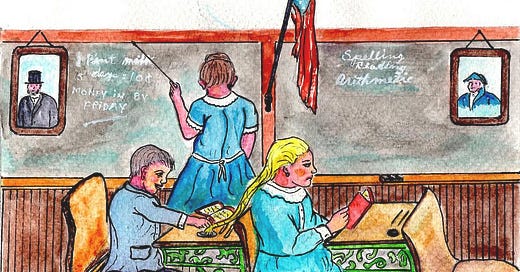The Rise and Fall (and Rise Again) of Useless Stuff for the Classroom
When education and business engineer poor compromises, teachers pay the price.
Children used slates to write their lessons in a one room school house.
It might be tempting to consider it part of the aesthetic of being an Abecedarian in the 1800s, but it was a function of necessity.
Paper was expensive, yes, but more than this writing on paper required the use of an inkwell. In a classroom packed full of students of all ages in long pigtail braids- sat one in front of another- it was a situation rife for artist interpretation. In other words, the ink got everywhere, sometimes intentionally and sometimes as a result of kids being kids.
So, parents and business people saw learning to write with ink and paper as an imperative to improving wealth and teachers saw it as a pain in the suspenders and topcoat.
Eventually, pencils were invented. A good middle ground, as lead does not lend itself to being knocked off of desks or pigtail dipping. Paper was still expensive, but the expense was managed for the paper and the pencils because writing on paper was a good skill to learn and teachers now had tools to manage it in the classroom.
I could retell the resistance to the adoption of calculators in classrooms, but it’s become its own legend with the intended lesson to learn outstripping what happened.
Instead, I’ll tell you about Bugs in Boxes in the school I para’d at. I have always been an early adopter and quickly called dibs on the first classroom PC that came available. This was around 1998. Prior to that we had labs, which are not like the lab you are thinking of now. Labs were rows of computers, in which every 3rd had burnt up it’s motherboard so that students could no longer play Mavis Beacon or Oregon Trail. Kids looked forward to the lab so that they could harass each other and try to get the computer to freeze because they lacked inkwells to cause trouble with.
In any case, I saw classroom PCs as a way to to make computers part of the instruction, rather than an object of instruction. I thought if adult instructors familiar with student academic needs could decide who used the machine and for what (rather than a random 45 minutes learning to type and whatever Oregon Trail was supposed to teach them) we could make real progress.
You’d think I’d burnt Horace Mann’s Lectures on Education in the break room.
“That’s not how you teach kids [insert topic]”.
”Let’s wait until we know for sure.”
But of course, you can’t know for sure unless someone goes first and I was already following early tech and gravitating towards the idea of fail fast. If I put kids on for 2 weeks, and we did a running record or a progress check and nothing, I’d stop. If I saw behavioral distress, immediate stop.
What no one wanted to say is that we had kids standing still on traditional methods too. I hate to say it, but in many cases it would have been impossible to go slower or do worse.
Eventually, I put my own kid on it, and we saw an increase and people warmed up to it. Eventually Reader Rabbit came on the scene and all was well.
These conflicting forces, business pushing to move too fast and education reluctant to move at all, leads to really terrible compromises I like to call Useless Stuff.
Examples sure to offend someone:
Ning : an answer to administrators resistance to paying for central repository for sharing classroom management tools and other collaborative efforts, “free'“ Ning was free until it wasn’t. Then, in one swoop, the folks it was gone along with everything in it. “Thems the breaks” seemed to be the attitude, when in reality it was devastating to many educators.
Interactive Whiteboards: Silicon Valley knows better than you, tech is an imperative skill for business and kids want it. (Like inkwells?). But teachers like the opportunity to instruct a whole group and lead discussion on a board. Viola! Only..not Viola. Implementation was low from the start, but luckily you can recycle responsibly rather than using them as lunch room partitions (something I’ve actually seen)
Ten Marks: “There is such a large body of work connected with TenMarks, to just close it down is such academic loss,” he tweeted. “How about making a grand gesture and make it all open source?” Glen Warren, literacy leader.
The issue with Ten Marks is that someone has to pay enough to make building worth it. It wasn’t worth it to Amazon, or anyone else who could have bought it. I often hear the argument that they ought to do it out of the goodness - but generally that mindset doesn’t lead you to the kind of money that lets you do it.
Side note: Have a look around at “Free” tools (not freemium, big difference) and check the quality.
I could go on, but I’m sure you can name more on your own.
And here we are again. AI is on the scene. Business people tell us that AI is imperative for functioning in the modern work force.
Teachers tell us AI is a looming nightmare.
The parallel to ink is far from exact- it’s easy to detect and prevent ink from entering your classroom and nearly impossible to detect and prevent Generative AI from entering. (AI is almost certainly already in your classroom and has been for a while.)
What we need is a pencil. Not a compromise but a real solution that marries the need to learn how to use a tool with the realities of classrooms.
Otherwise we’re headed to the next wave of useless compromises that make money and not much else.



